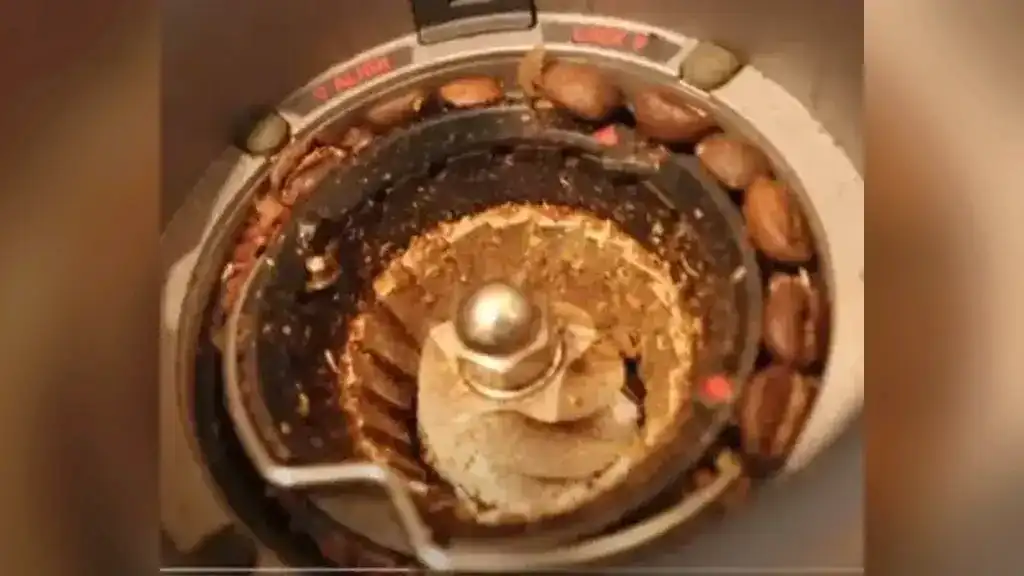Cleaning Flat Burr Grinders and Conical Burr Grinders Fast
One of the easiest tasks regarding automatic coffee grinders is how to clean them. But if we neglect the cleaning process for too long, you will need a deep cleaning that takes more than ten minutes. Over time, a lot of dirt seeps into the electric coffee grinder. These are dirt, such as dust, small grains of sand, and leftovers from the grinding process such as ashes and oils.
Yes oils. When ground coffee beans, especially fine grinding, they release the light oils responsible for the aroma of coffee. Over time, these oils will build up, and then you will begin to taste an unwanted taste in your coffee that you weren’t used to before. Also, this dirt when it enters the coffee grinder will weaken the motor, overwork it, and cause it to malfunction.
In this article, I will talk about my experience cleaning electric coffee grinders. If you want to know how to clean manual coffee grinders, the procedure is the same but cleaning manual grinders is much easier than cleaning electric coffee grinders.
Know This before Your First Attempt to Clean an Electric Burr Coffee Grinder
WARRNINGS:
- Do not deep clean electric burr coffee grinders unless you have not cleaned them for a long time. I do not recommend deep cleaning of electric coffee grinders in short periods. Because it leads to the wear of parts and the scratching of the sensitive parts of the coffee machine. It is true that these parts scratch with frequent use, but it is better to wear out from prolonged use than to wear from poor cleaning.
- Read the manual for the electric coffee grinder before removing any parts. Each electric coffee grinder comes with a user manual detailing how to use it. And also how to disassemble the coffee grinder parts in the correct order. And also the tools you need to disassemble the Coffee grinder parts. This will definitely save you a lot of trouble if this is your first time taking apart a coffee grinder.
- Read the coffee grinder manual to see if cleaning the coffee grinder with certain materials or foods such as rice violates the warranty. Because many of the premium quality coffee grinders are designed with precision for grinding coffee beans. But when grinding rice, for example, the blades may wear out and spoil very quickly, because rice is considered to be stiffer than coffee beans.
- Do not use a toothbrush. The toothbrush really does cleaning, but its problem is that it leaves unwanted scratches. Removing these scratches requires specific skill and equipment, especially if the burrs are made of stainless steel.
While you’re mastering the art of cleaning your coffee grinder, why not ensure you’re using the best equipment? Dive into our Top-Rated Electric Coffee Grinders to discover the perfect match for your brewing needs. Elevate your coffee experience today!
The material of your grinder’s burrs plays a crucial role in the consistency and flavor of your grind. Have you considered the material of your grinder’s burrs? Understanding the difference between ceramic vs steel grinder comparison can further elevate your coffee experience.
Did you know that the oils released during coffee grinding can build up and alter your coffee’s taste? While mastering the art of cleaning your grinder, consider upgrading to the finest hand-operated coffee mills. Dive in and elevate your coffee experience!
Tools and Stuff you Need
- Hot, soapy water: Use hot, soapy water only if you need a deep cleaning of the electric coffee grinder. Because cleaning using water will make the cleaning process more difficult, and I will explain to you later why.
- Microfiber cloth: The microfiber cloth is very suitable for cleaning an electric coffee grinder, especially for drying soap and water if they are used in the cleaning process. The fiber cloth has a very fine fiber that does not leave dust or water particles without cleaning it. Towels made of microfiber have the ability to absorb water very quickly because they contain 200,000 collars per inch of fabric.
- Soft Brush: That are made for Cleaning Coffee grinder. Usually, this brush is very soft and made to special specifications. I recommend using this brush, especially as it is supplied by the same electric coffee grinder. If the cleaning brush did not come with your electric grinder, you can use any other brush, provided that the threads are very soft and cohesive.
- Cotton sticks: It will be useful when you need to reach hard-to-reach places and spots using your hand or a cleaning brush. Usually, you will need it if your electric grinder has not been cleaned for an extended period of time.
- Old coffee beans: This step is very important, especially if you use soap and water in the cleaning process. Because it helps restore the flavor on the coffee grinder before making your first cup of coffee after the cleaning process is finished.
- Coffee Grinder Cleaning Pellets: They are commercial tablets that are specially made to clean commercial coffee machines, but it is not forbidden to use them for your electronic grinder at home, but do not use many cleaning pellets.
The 8 Steps to Clean Your Burr Coffee Grinders
These steps are easy and not complicated at all, and are suitable for cleaning electric coffee grinders and manual coffee grinders. There are some slight differences since the manual coffee grinder is easier to clean, but we will focus on how to clean electric coffee grinders, especially those that have conical burrs or flat burrs. I didn’t talk about blade grinders because cleaning them is no different than cleaning burr grinders.
1. Un-plug your grinder
I must mention this step because it is without a doubt a very important one. It is not recommended to carry out the cleaning process with the coffee grinder connected to electricity at all because it may cause harm to you, and surely it will cause serious damage to the motor of the coffee grinder.
As you progress through the next steps, I will ask you to re-plug the grinder to electricity, but be careful, you will only re-plug it for less than 30 seconds. I ask you to be careful and alert.
2. Quick cleaning: vacuum or air pressure
This method is suitable if you keep your electric coffee grinder clean from time to time. Open the hopper and use a vacuum cleaner or air pressure to quickly remove ground coffee and trapped dirt. Go to the next step.
If the coffee grinder has not been cleaned for a very long period of use. I don’t recommend using this method, rather go to step three directly.
While mastering the art of cleaning your coffee grinder, don’t you want to ensure you’re using the best equipment? Dive into our Top-Rated Commercial Coffee Mills and elevate your coffee grinding experience to professional levels!
3. Re-plug the grinder again
Plug the grinder with electricity and then run the grinding process for no more than 30 seconds without adding any coffee beans or other food or materials. This method will help you to shake the coffee grinder and cause the dirt to be easier to clean in the next step.
When finished, unplug the electric coffee grinder and proceed to the next step.
4. Remove the coffee grinder parts
Before taking this step, you should read the instruction manual provided by the manufacturer so that you can disassemble the parts of the electric coffee grinder without error.
Carefully remove the hopper and then remove the external grinding chamber as it is the one that secures the burr grinding blades. Finally, remove the conical burrs or flat blades.
I will not explain the cleaning process for blade grinders as the technique used is the same for both burr and blade grinders. Blade grinders do not usually have an external grinding chamber, so blades can be easily removed directly. After you’re done, move on to the next step.
5. Clean the parts one by one
If the parts are very dirty. Start with hot, soapy water. The hot water will loosen the oils quickly, while the soap will make it easier to rinse them off with a microfiber towel.
If the parts are not very dirty or need a little cleaning, I recommend using a brush and a fiber towel to remove minor grime, as rinsing with soap and water will significantly reduce the flavor that the grinding machine has acquired during the previous time.
After completing the previous steps, now use the brush to get rid of grime, plankton, and coffee residue, then use the fiber towel to rinse each part of the coffee grinder gently and carefully. Before proceeding to the next step, make sure that any part of the electric coffee grinder is free of soapy water.
6. Replace coffee grinder parts
Now carefully reassemble the parts of the automatic coffee grinder, unlike the order in which you removed the parts. You may need to re-read the instruction manual.
If you are not sure how to install the coffee parts, stop immediately and go to the nearest coffee machine professional to help you with the installation process.
7. Grinder Cleaning Pellets
This step is completely optional. I prefer to use coffee grinder cleaning tablets for commercial purposes, but with an automatic or manual grinder this is never prohibited.
These tablets are mostly made of granules, cornmeal, bran, and fiber and are combined together using cornstarch, magnesium citrate, etc. Using them is never harmful on your burr coffee grinder.
8. Use old coffee beans
Before the final use of the electric coffee grinder. I recommend grinding a small amount of old coffee beans, to restore the flavor of the coffee that your electric grinder has lost after the cleaning process.
In this step, you have already finished cleaning your automatic coffee grinder.






![5 Best Coffee Grinders: ([year]) From Conical-Burr to Blade Best-Coffee-Grinders-1](https://coffeescan.com/wp-content/uploads/Best-Coffee-Grinders-1.webp)
![Leading Commercial Coffee Grinder ([year]) The Secret to a Successful Café Best-Commercial-Coffee-Grinder-1](https://coffeescan.com/wp-content/uploads/Best-Commercial-Coffee-Grinder-1.webp)


